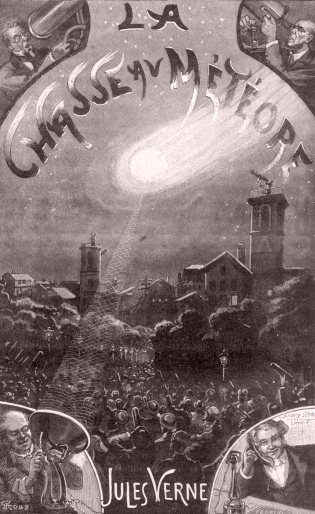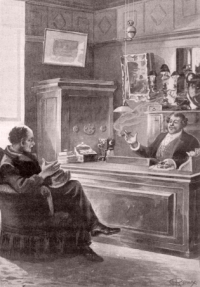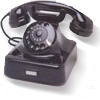 My first computer was a Commodore 64 (C64) back in the beginning of the 1980s. When you switched it on it gave you a black
screen with a blinking BASIC prompt. That was all. From there you could start and do what you liked, till the limits of the
machine were reached. More than a decade later I installed an operating system on a PC. Already at the start of the procedure
the machine asked me to type in my name! What presumptuousness, I thought. When hell has frozen over, I will tell you my
real name. From the top of my head came the name of a childhood-hero of mine: The fictitious character "Zephyrin
Xirdal" out of a novel by Jules Verne. I typed it in and the name stuck. Now it is my real name in cyberspace.
My first computer was a Commodore 64 (C64) back in the beginning of the 1980s. When you switched it on it gave you a black
screen with a blinking BASIC prompt. That was all. From there you could start and do what you liked, till the limits of the
machine were reached. More than a decade later I installed an operating system on a PC. Already at the start of the procedure
the machine asked me to type in my name! What presumptuousness, I thought. When hell has frozen over, I will tell you my
real name. From the top of my head came the name of a childhood-hero of mine: The fictitious character "Zephyrin
Xirdal" out of a novel by Jules Verne. I typed it in and the name stuck. Now it is my real name in cyberspace.-- WORK IN PROGRESS, to be continued --
The complete novel La Chasse au Météore (in French), including the original illustrations by George Roux is available online as hypertext.
http://verne.jules.free.fr/bd/Herge.htm
L'étoile mystérieuse (Hergé).
Titre d'autant plus intéressant que la fameuse étoile devient une ile ! Voir L'ile mystérieuse (Verne)
De nombreux tintinophiles critiquent le livre "Tintin chez Jules Verne"... Effectivement, il n'est pas sans défaut. La preuve : il passe à coté de la plus ENORME similitude entre deux oeuvres de ces auteurs. Je veux parler ici de "L'Etoile Mystérieuse" et de "La Chasse au Météore" (1). Quelques 'coïncidences' (puisqu'il ne s'agit évidemment que de cela ;o)) A la base, les scénarios sont quasiment identiques : Un météore va s'écraser sur la Terre et une "chasse" s'organise pour s'en emparer. Deux scientifiques interviennent dans cette 'chasse'.
* Chez Hergé, Hippolyte Calys :
- "Du radium?... Jamais de la vie !... (...) Moi Hippolyte Calys, j'ai découvert un métal nouveau, auquel je donnerai mon nom : le calystène."
- "Ceci est une photo spectroscopique du bolide qui nous a frolé cette nuit. Chacune de ses lignes, ou chacun de ces groupes de lignes est caractéristique d'un métal (...)"
* Chez Verne, Zéphyrin Xirdal
- "Ceci, messieurs, c'est du Xirdalium, corps cent mille fois plus radio-actif que le radium". Et ce Xirdalium permettra à Zéphyrin de modifier la trajectoire du fort intéressant bolide :
- "Les rayons émanés du bolide ont été soumis à une analyse spectrale et la disposition de leurs raies a permis de reconnaitre avec certitude la substance du corps lumineux. (...) Ce bolide est en or, en or pur (...)
Evidemment dans les deux cas, le bolide (ou un morceau de celui-ci) tombera :
* Hergé : "La station polaire de Cap Moris (cote Nord du Groenland) annonce qu'un aérolithe a dû tomber dans l'Océan Arctique. Des pêcheurs de phoque ont vu une boule de feu traverser le ciel et disparaitre à l'horizon. Quelques secondes plus tard la terre tremblait et la banquise se disloquait"
* Verne : JBK Lowenthal (opposant à Xirdal dans cette chasse) affirme que : "on est dès à présent en mesure d'annoncer ce sui suit :
1°) Le bolide tombera
2°) La chute s'éffectura le 19 août (...)
3°) Elle aura lieu dans un rayon de dix kilomêtres autour de la ville d'Uppernik, capitale du Groenland."
(...) "A sept heures, un coup sourd se fit entendre, si rude que l'île en trembla sur sa base. Quelque instant plus tard, un indigéne accourait à la maison occupé par M. de Schnack. Il apportait la grande nouvelle... Le bolide était tombé sur la pointe Nord-Ouest de l'île d'Upernivik. Aussitôt, ce fut une ruée.(...) Enfin, il est là...sur l'île... il n'est pas au fond de la mer..."
Dans les deux cas, le météore finit par s'enfoncer dans la mer :
- " Tout à coup, un effroyable craquement, se fit entendre... La roche venait de céder, et le météore s'abimait dans la mer." (Verne)
- "Que dites vous?... un tremblement de terre? et l'aérolithe s'enfonce?...." (Herge)
Il y aurait encore beaucoup à dire mais bon ... une coïncidence de plus ou de moins ne vous convaincra pas !
Ah, si, une dernière "coïncidence". On trouve dans l'Etoile Mystérieuse une certain "Herr Doktor Otto Schulze de l'université d'Ièna". Or, on trouve dans un autre roman de Verne un certain "M. le professeur Schultze, de l'Université d'Iena" ! Et en plus d'avoir le même nom, d'enseigner à la même université, ces deux professeurs ont quasiment la même tête ! Coïncidence ! (*)
(*) relevé dans Tintin chez Jules Verne (Lefrancq)
http://www.sffworld.com/authors/v/verne_jules/sffreviews/meteor.html
The Chase of the Golden Meteor
by Jules Verne
Bison Books - 0-8032-9619-3 - 292pp/1998
Reviewed by Steven H Silver
In this year, which saw the release of two meteor-striking the earth films as well as several similarly themed novels, it is, perhaps, fitting that Bison Books has elected to reprint Jules Verne's novel The Chase of the Golden Meteor, originally published as Chasse au météore in 1909. The novel tells the story of two friends, Dr. Sydney Hudelson and Mr. Dean Forsyth, both of Whaston, Virginia, who simultaneously discover a celestial body which seems to be in orbit around the Earth. Throughout the book, Verne examines the stresses this discovery places on their families as each man views himself the proprietor of the object. Matters are not helped by either the impending marriage of Hudelson's daughter to Forsyth's nephew, nor by the revelation of the Paris Observatory that the object is made of solid gold. As is typical with Verne's writing, his characters are defined less by characterization as they are by expository paragraphs which are included immediately after the characters' introductions. In this manner, Verne introduces Seth Stanfort and Judge Proth within the first six pages. Other, more important characters, are introduced in similar manner in subsequent pages. In fact, Seth Stanfort and his wife, Arcadia, are introduced at the beginning of the novel, and at a few places throughout, with very little effect on the narrative as a whole. Instead, Verne focuses, as much as he does, on Dean Forsyth and Sydney Hudelson. Even these men take a backseat in Verne's story. The real star of the novel is the titular golden meteor and the feud it engenders between Hudelson and Forsyth. The Hudelson-Forsyth feud over who discovered the bolide first, seems to be based on such nineteenth-century feuds as the one between Othniel Marsh and Edward Cope. Although the men begin the novel as friendly rivals, their scientific interest escalates the rivalry to the point where they cannot abide the other man's presence. Because so much of the novel is told at a distance, relying on narration of events rather than dialogue between character, the reader is rarely shown any of the Hudelson or Forsyth households really attempting to reconcile the two men. Even when Francis Gordon, Forsyth's nephew, and Jenny Hudelson, Gordon's fiancee, attempt to reconcile their elders, the action is only described without any of the details. The feud is exacerbated when the meteor suddenly changes course, due to the influence of Parisian genius Zephyrin Xirdal. Originally, Verne claims that the meteor is in a stable orbit, although the bolide's actions in the early chapters seem to have it whizzing around the sky at random. Xirdal is a French eccentric genius whose work is lost because he has no interest in exploiting it. If asked at the right time, he'll give someone his researches, otherwise they wind up in a heap around his flat. When he turns his attention to the meteor, he decides he wants to own it, not for the money, but for the purpose of fulfilling his own ego. While Verne has shown that he can create unique as memorable characters (i.e. Captain Nemo), he has proven, time and again, that characterization is not his strong suit. Instead, his novels usually rely on a novel scientific idea portrayed in a clever and exciting way. . . journeying to the center of the earth, submarines, flights to the moon, etc. While The Chase of the Golden Meteor includes a novel concept at its center, the idea is so implausible, and done in such a pedestrian manner, that the novel does not hold up particularly well, even in this year of asteroidal disaster films.
Story stark von Vernes Sohn Michel Verne modifiziert










 URI: http://maxmod.xirdalium.net/zephyrin_xirdal.html
URI: http://maxmod.xirdalium.net/zephyrin_xirdal.html